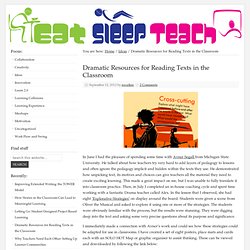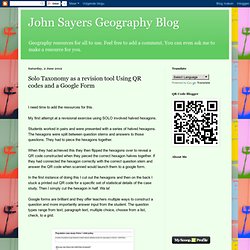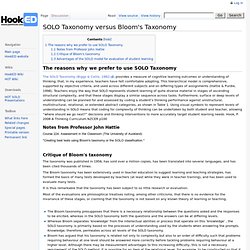

Course: Solo. In order to achieve both at school and once they leave school students need to gain more than a superficial understanding of key concepts.

In order to move students past a superficial level of understanding teachers at St. Andrew's College have been exploring ways to enocurage students to be conscious of the depth of their understanding. One answer is SOLO Taxonomy. It is a tool for classifying the extent of pupils’ understanding. Students (and teachers) can use the SOLO taxonomy, along with associated maps and assessment rubrics to identify the stage they are working at, then work upwards through the levels as they build their knowledge.
ASTsupportAAli : Latest addition2 Roll a series... Agility- The teaching toolkit: ROLL A... series... Solo taxonomy network to share practice and resources. SOLO Hexagon Generator ? HookED. LGolton: #solo stampers are here…... Ideas and ramblings from an English teacher. New School Year – More SOLO. Over the summer, I decided that one of my new school year resolutions was to embed SOLO into my teaching across all three key stages.

I dabbled last year (see my previous posts here) and was very pleasantly surprised with how effective it appeared to be. However, being a sceptic at the best of times, I decided that a more detailed and consistent trial was needed. Starting Points With each of my classes I have introduced the concept of SOLO taxonomy using the excellent Youtube Lego video. I also stuck a simple SOLO level explanation sheet in the back of their English books. Aim High SOLO Display We are now three weeks into the new term and I have used SOLO the most with Year 10, although I have tried to embed it into the majority of lessons. Youtube My two Year 10 classes are roughly parallel in ability and are studying Wilfred Owen for their first controlled assessment. Marginal Gains SOLO Skills Poetry Feedback Did you enjoy the lessons? Some of the suggestions for improvements were: Going SOLO with Charles 1. Kerry ⋅ History ⋅ History, SOLO ⋅ No comments Image by lisby1 I have developed more than a passing interest in SOLO taxonomy and I hang on to words of encouragement from those who urge, “Go for it.”

It just makes sense to me; a simple way to enable students to note how far along the road they are to becoming astute critical thinkers. Today’s year 8 History lesson covered the trial and execution of Charles 1 in 1649. To raise students’ interest in the topic, I showed Russel Tarr’s 3 minute video clip of the execution (To Kill a King, 2002). I then introduced the big question; one which was beyond the scope of a single lesson, but which was definitely at the Extended Abstract level.
It was then time to move onto the lesson content. However, discussion was good and the pairs of students approached the activity differently. Dramatic Resources for Reading Texts in the Classroom. In June I had the pleasure of spending some time with Avner Segall from Michigan State University.

He talked about how teachers try very hard to add layers of pedagogy to lessons and often ignore the pedagogy implicit and hidden within the texts they use. He demonstrated how unpicking text, its motives and choices can give teachers all the material they need to create exciting learning. This made a great impact on me, but I was unable to fully translate it into classroom practice. Then, in July I completed an in-house coaching cycle and spent time working with a fantastic Drama teacher called Alex. In the lesson that I observed, she had eight ‘Explorative Strategies’ on display around the board. I immediately made a connection with Avner’s work and could see how these strategies could be adapted for use in classrooms.
I am now using this with all classes. I would love some feedback on this approach and, in particular, any suggested improvements. Discover Yourself! Thereal_MrH : #soloarmy Latest solo prog... Missjillyteach : Thanks to @en_sport for in... Teachers Use Twitter As Their Preferred CPD Tool. Introduction To SOLO Taxonomy By David Didau. About this blog and me. John Sayers Geography Blog: Solo Taxonomy as a revision tool Using QR codes and a Google Form. I need time to add the resources for this.My first attempt at a revisional exercise using SOLO involved halved hexagons.Students worked in pairs and were presented with a series of halved hexagons.

The hexagons were split between question stems and answers to those questions. They had to piece the hexagons together. When they had achieved this they then flipped the hexagons over to reveal a QR code constructed when they pieced the correct hexagon halves together. If they had connected the hexagon correctly with the correct question stem and answer the QR code when scanned would launch them to a google form.In the first instance of doing this I cut out the hexagons and then on the back I stuck a printed out QR code for a specific set of statistical details of the case study. Then I simply cut the hexagon in half.
Solo Taxonomy and MentorMob. A Match Made in Heaven? SOLO Taxonomy with Pam Hook. SOLO Taxonomy 1: My first few weeks with SOLO « iTeachFreely. The Structure of Observed Learning Outcomes (SOLO) Taxonomy developed by Biggs and Collis (1982) is a model of learning outcomes that helps schools develop a common understanding and language of learning and in so doing helps teachers and students to understand the learning process and learning outcomes. - Pam Hook and Julie Mills, 2011 Lesson 1 About 4 weeks ago, SOLO was something I daydreamed about a lot, but done nothing to actually implement.

Artichoke. Abstract: Claims for the transformative effects of e-learning on student learning outcomes imply changes in the nature of learning when learning is mediated by technology.

If it can be shown that the nature of learning changes in a distinctive way when learning is mediated by technology (Andrews 2011) then it seems plausible that the evidence for learning might also change. Essential Resources. A fine WordPress.com site. SOLO Taxonomy versus Bloom's Taxonomy. The SOLO Taxonomy (Biggs & Collis, 1982), provides a measure of cognitive learning outcomes or understanding of thinking, that, in my experience, teachers have felt comfortable adopting.

This hierarchical model is comprehensive, supported by objective criteria, and used across different subjects and on differing types of assignments (Hattie & Purdie, 1998). Teachers enjoy the way that SOLO represents student learning of quite diverse material in stages of ascending structural complexity, and that these stages display a similar sequence across tasks. Furthermore, surface or deep levels of understanding can be planned for and assessed by coding a student’s thinking performance against unistructural, multistructural, relational, or extended abstract categories, as shown in Table 1.
Downloadable Resources. Solo Geography 17 Category links. Solo Taxonomy And MentorMob. A Match Made In Heaven?